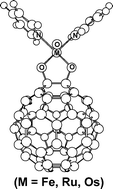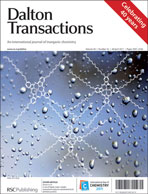A computational study of cycloaddition reactions of d8 metal tetroxide (Iron, Ruthenium, Osmium) complexes with C60†
Abstract
The potential energy surfaces of the cycloaddition reactions MO4(NC5H5)2 + C60 → MO4(NC5H5)2(C60) (M = Fe, Ru, and Os) have been studied at the B3LYP/LANL2DZ level of theory. It has been found that there should be two competing pathways in these reactions, which can be classified as a [6,5]-attack (path A) and a [6,6]-attack (path B). Our theoretical calculations indicate that, given the same reaction conditions, the cycloaddition reaction of C60via [6,6]-attack is more favorable than that via [6,5]-attack both kinetically and thermodynamically. This is in good agreement with the available experimental observations. A qualitative model, which is based on the theory of Pross and Shaik, has been used to develop an explanation for the barrier heights. As a result, our theoretical findings suggest that the singlet–triplet splitting ΔEst (= Etriplet − Esinglet) of the d8MO4(NC5H5)2 and C60 species can be a guide to predict their reactivity towards


 Please wait while we load your content...
Please wait while we load your content...